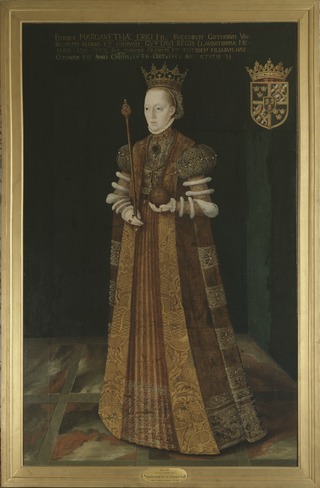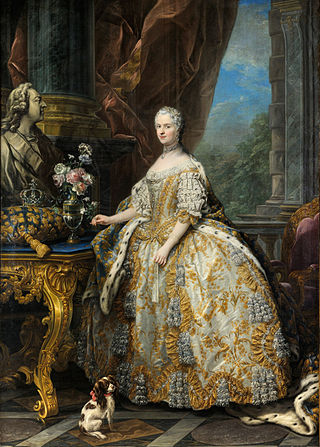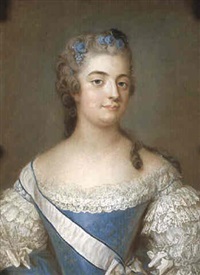Related Research Articles

Lensgreve Johann Friedrich Struensee was a German-Danish physician, philosopher and statesman. He became royal physician to the mentally ill King Christian VII of Denmark and a minister in the Danish government. He rose in power to a position of "de facto" regent of the country, where he tried to carry out widespread reforms. His affair with Queen Caroline Matilda caused a scandal, especially after the birth of a daughter, Princess Louise Augusta, and was the catalyst for the intrigues and power play that caused his downfall and dramatic death.

Margaret Leijonhufvud was Queen of Sweden from 1536 to 1551 by marriage to King Gustav I. She played a political role as the advisor of, and the intermediary to, her spouse the King.

Maria Karolina Zofia Felicja Leszczyńska, also known as Marie Leczinska, was Queen of France as the wife of King Louis XV from their marriage on 4 September 1725 until her death in 1768. The daughter of Stanisław Leszczyński, the deposed King of Poland, and Catherine Opalińska, her 42-years and 9 months service was the longest of any queen in French history. A devout Roman Catholic throughout her life, Marie was popular among the French people for her numerous charitable works and introduced many Polish customs to the royal court at Versailles. She was the grandmother of the French kings Louis XVI, Louis XVIII and Charles X.

Caroline Matilda of Great Britain was Queen of Denmark and Norway from 1766 to 1772 by marriage to King Christian VII.

Juliana Maria of Brunswick-Wolfenbüttel-Bevern was Queen of Denmark and Norway from 1752 to 1766 as the second consort of King Frederick V of Denmark and Norway. She was mother to the prince-regent, Hereditary Prince Frederick of Denmark and Norway, and was herself de facto regent from 1772–1784. King Christian VIII of Denmark and every subsequent Danish monarch excluding Christian IX descends from her.

Anne Cathrine Benthagen, known in history by her nickname Støvlet-Cathrine, was a Danish prostitute, one of the best known courtesans in Copenhagen in the 1760s and the official royal mistress of King Christian VII of Denmark.

Hedvig Catharina von Fersen, née De la Gardie was a Swedish noble. She was the daughter of the General and riksråd count Magnus Julius De la Gardie and the political salonist Hedvig Catharina Lilje, and sister of scientist Eva Ekeblad.

Marie ("Mimi") Baronessvon Schleinitz was an influential salonnière of the early German Reich in Berlin and one of the most important supporters of Richard Wagner.

Louise Scheel von Plessen was a Danish lady-in-waiting and memoir writer. She wrote the memoirs of her time at the Danish court: Mémoires de la cour de Danemark.

Sophia Magdalena Krag-Juel Vind, née von Gram (1734–1810), was a Danish Salon holder, landowner and noble. She is considered to have exerted considerable political influence in Danish politics during the late 18th century.
Charlotte Helene von Schindel (1690–1752) was a Danish noble, a lady in waiting and a royal mistress of King Frederick IV of Denmark.
Frederikke Louise Stolberg, also known as Luise Gramm was a Danish saloniste, playwright and letter writer. She is attributed with a certain degree of political influence upon various power holders in the policy of Denmark and Germany; she participated in the 1784 coup in Denmark. Her preserved correspondence is regarded as a valuable historic source about the courtiers of the Danish royal court of her time.

Christine Sophie von Gähler, Countess von der Goltz, née von Ahlefeldt was a Danish noble and courtier, known for her love life and unconventional life style, known in history as one of the Three Graces of the Danish royal court.

Elisabet von Eyben (1745–1780), was a Danish courtier, lady in waiting to the queen consort of Denmark, Caroline Matilda of Great Britain, from 1766 until 1771. She was the queen's confidante in her love affair with Johann Friedrich Struensee but was fired in 1771 because of rivalry between her and the queen about Struensee. After the fall of Struensee, von Eyben gave testimony that seriously damaged the cause of the queen during the divorce.
Amalie Sofie Holstein (1748-1823), was a Danish noblewoman and courtier, known for her love life and unconventional life style, known in history as one of the Three Graces of the Danish royal court.
Anna Sofie von Bülow (1745-1787), was a Danish noble and courtier, known for her love life and unconventional life style, known in history as one of the Three Graces of the Danish royal court.

Caroline von Schimmelmann, née Tugendreich Friedeborn (1730–1795), was a Danish countess.
Ida Hedevig Moltke (1744–1816) was a Danish countess and letter writer.
Court Mistress or Chief Court Mistress is or was the title of the senior lady-in-waiting in the courts of Austria, Denmark, Norway, the Netherlands, Sweden, Imperial Russia, and the German princely and royal courts.

Thérèse-Lucy de Dillon née de Rothe, was a French countess and courtier, lady-in-waiting to queen Marie Antoinette of France in 1780–82. She belonged to the intimate circle of friends of the queen and was for a while known as one of her favorites.
References
- August Fjelstrup: Damerne ved Karoline Mathildes Hof , 1909.